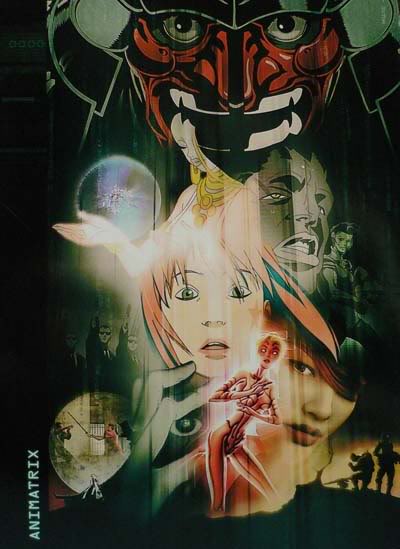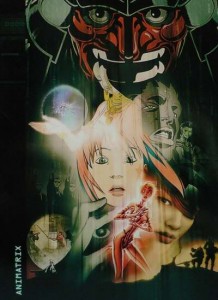
 Archival interview with Mike Arias from the official Matrix website.
Archival interview with Mike Arias from the official Matrix website.
MATRIX: What is your background in regards to anime and in general?
MIKE: I started out about 13 years ago doing special effects motion control photography, miniature photography and traditional effects. I worked on a couple of movies: two A Nightmare on Elm Street films, and a movie called The Abyss. I spent a long time working on feature film effects, and then I worked on a ride for Universal Studios called Back to The Future, which is how I met John Gaeta, the Visual Effects Supervisor for THE MATRIX films. Back then he was a camera assistant and I was programming motion for some ride vehicles.
Since then I’ve been living on and off in Japan for 9 or 10 years now, developing computer graphic software, and also working in production, mostly on digital effects as used in Japanese animation. So I’ve been able to meet and work with a lot of these directors who will be working on THE ANIMATRIX.
MATRIX: How is anime received in Japan?
MIKE: Anime is like live action here (in the U.S.): you have some that are made for children and some that are made for general audiences… all genres. Anime is parallel to the way comic books are accepted in Japan, it’s not seen as something frivolous, and is definitely respected as an art form, both in comic books and cel animation. Japanese people are used to the grammar and the language of cel animation and comic book art in a way that I don’t think American audiences have ever really gotten past the idea of needing talking dinosaurs or singing and dancing elephants. Cartoons in the United States are still very much made for kids, which is not a bad thing, but it’s really just the tip of the iceberg, I think.
MATRIX: How did THE ANIMATRIX start?
MIKE: I’m not sure where the idea for the ANIMATRIX came from. My assumption is that because Andy and Larry Wachowski [Wachowski, Writers / Directors] love and are very knowledgeable about Japanese animation, they saw a way of expanding on THE MATRIX and doing things they might not have been able to do very easily in their feature films. I have a feeling that Japanese animation served as some of the inspiration for THE MATRIX, so perhaps they are also paying homage to some of the Japanese animation directors they like.
The ANIMATRIX was originally conceived of as a TV series, but the practical problems involved in producing a TV series, and the people we wanted to work with as directors, made that difficult. So we ended up with this project being the way it is now: nine short anime films, each 6 to 10 minutes in length and each with a non-episodic structure. No single film is necessarily a continuation of any of the others. Some of them are based on stories Andy and Larry have written, or are written by the Japanese directors in consultation with Andy and Larry. All the stories are set in the world of THE MATRIX.
We have one episode which is conceived of as an historical epic, which lets you in on a lot of what Andy and Larry had in their minds as back story behind THE MATRIX, but never gets explained in the films themselves, although it may be referred to indirectly. Some of the films are purely dramatic character oriented pieces, exploring the lives of different characters you don’t see in the films.
MATRIX: Tell us about the various directors collected for THE ANIMATRIX.
MIKE: These directors, without exception, all love THE MATRIX, but when asked if they want to do their own take on it or expand on it, I think some of them are a bit concerned about infringing on someone else’s territory. They see THE MATRIX very much as Andy and Larry’s baby – and you don’t necessarily want to take care of someone else’s baby.
One of my favorites is a fellow named Yoshiaki Kawajiri who directed a movie which was released in the United States as Ninja Scroll, which is a movie that Larry and Andy talk about all the time. He wrote and directed PROGRAM, and also wrote WORLD RECORD, which was directed by Takeshi Koike. Kawajiri-san wrote an original story because he wanted to contribute something that is really personal.
Kawajiri-san has been directing animation forever. My favorite piece of his is a film called The Running Man [in Japan]; here in the United States it’s called Death Circus. It’s part of an omnibus comprised of three short films and visually it’s incredible. Kawajiri-san has an amazing sense for action and martial arts sequences, as well as crazy sci-fi.
Koji Morimoto, who is my favorite Japanese animation director of all time, also wrote and directed an episode for us called BEYOND. Katsuhiro Otomo directed a film called Akira, and his right hand man on both Akira and Manie Manie was Koji Morimoto. Morimoto-san directed the first of three episodes of a film called Memories, based on stories by Otomo – his episode is called Magnetic Rose in English, and it’s just intense.
Mahiro Maeda, who is doing our big two part historical epic, THE SECOND RENAISSANCE, actually has an anime series available in the United States, dubbed into English, called Blue Submarine 6, which is more or less like a James Bond sort of action show. He’s a huge fan of THE MATRIX and wanted to get in on this project; he was actually the first director who was committed to working on an episode.
MATRIX: How has the proccess of creating anime changed in recent years?
MIKE: The old style of animation would have artists first doing their sequential drawings on paper, then those drawings would get transferred to acetate transparent cels, which get back lit, painted and photographed on an animation stand. Now, that whole process of what is called inking and painting and photography, is all done digitally. The fact that all the drawings are now in digital form, although they started out being drawn by hand, has opened up a lot of avenues for other digital effects.
3D computer graphics, which is what I specialize in, is in places where you would never expect to see 3D computer graphics being used, at least in Japanese cel animation. We get a lot of 3D computer graphics being used to create special effects that would be very tedious to draw by hand, or to manipulate backgrounds, and we’re starting to do some 3D characters integrated with cel animation. One of the things I’ve been concentrating on is creating the software which allows the 3D data to be visualized or rendered in such a way that it blends in with everything that is drawn by hand.
MATRIX: How would you define your role in THE ANIMATRIX?
MIKE: Besides the 3D work, my job was also to work with Andy and Larry and the various directors on the Japanese side, to make sure they understood each other.
MATRIX: How severe was the language barrier?
MIKE: It wasn’t a problem for me because I speak Japanese, but we had some very strange phone calls with translators doing simultaneous Japanese to English, or English to Japanese translation. When everyone was in the same room, language was almost not an issue. But we dealt with not only cultural and language differences, but also the fact that one side of the telephone conversation just got out of bed, while the other side of the conversation was about to go to sleep.
We discovered that when the anime directors were in the United States, face to face with Andy and Larry, and everyone was standing over the same piece of crumpled napkin with a drawing on it, then language wasn’t an issue – everyone made sound effects to get their point across.
MATRIX: Thanks Mike.
Interview by REDPILL
November 2000

Be the first to comment